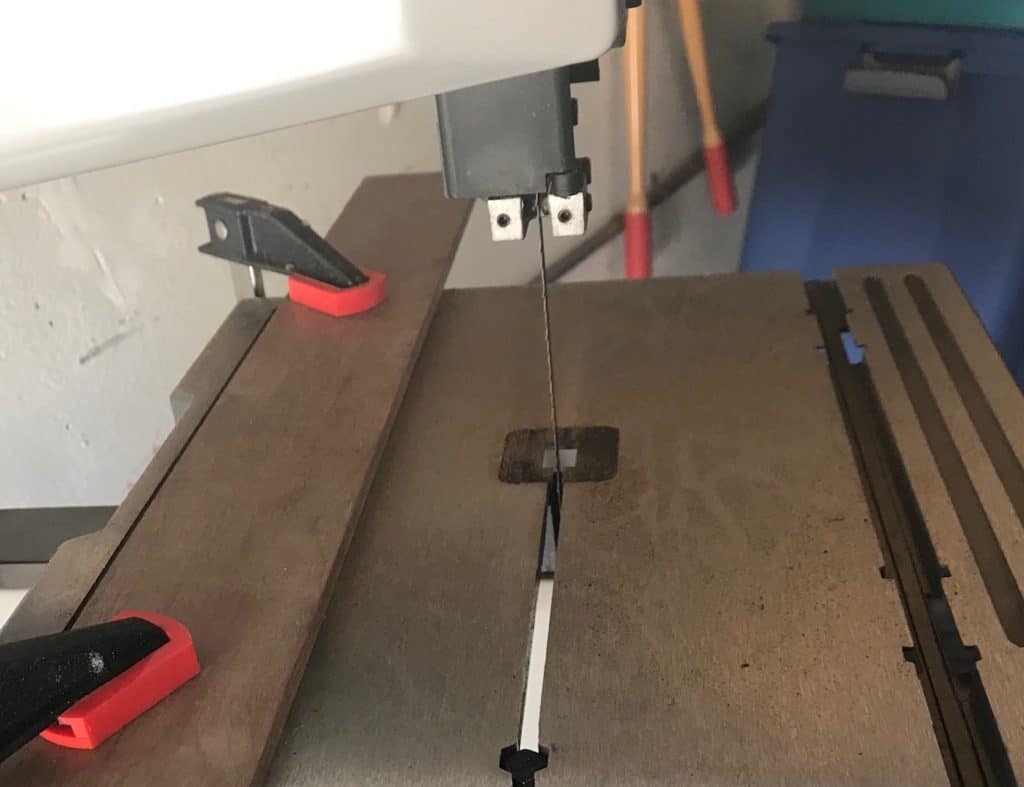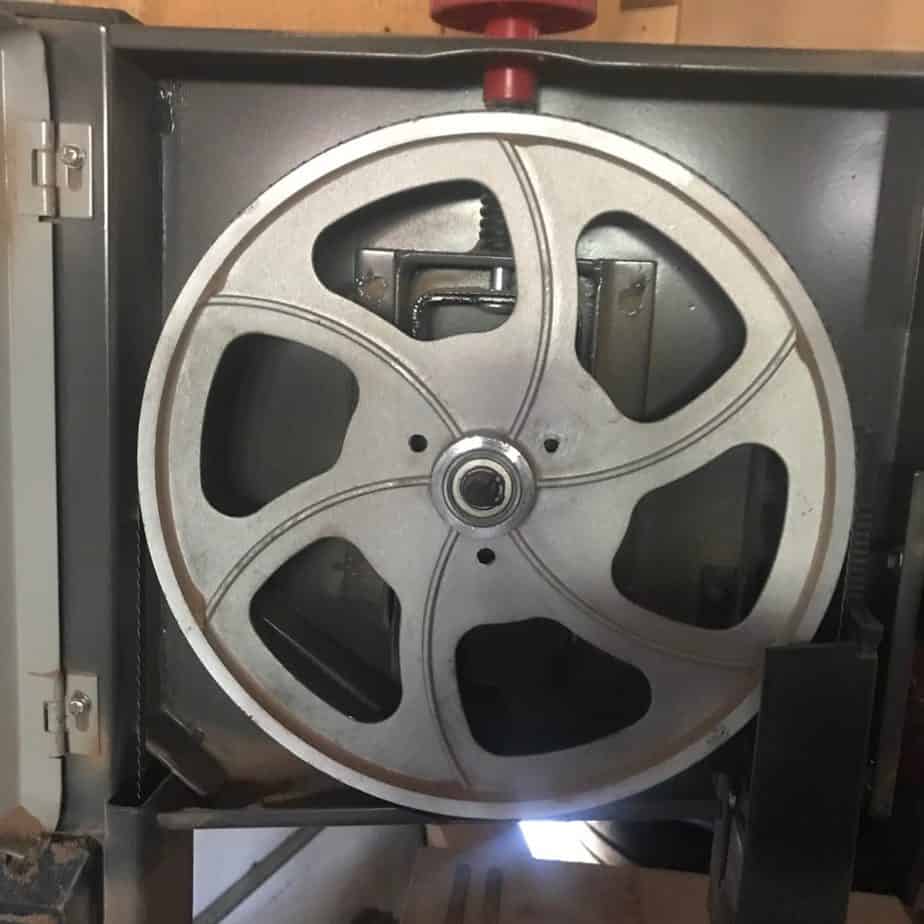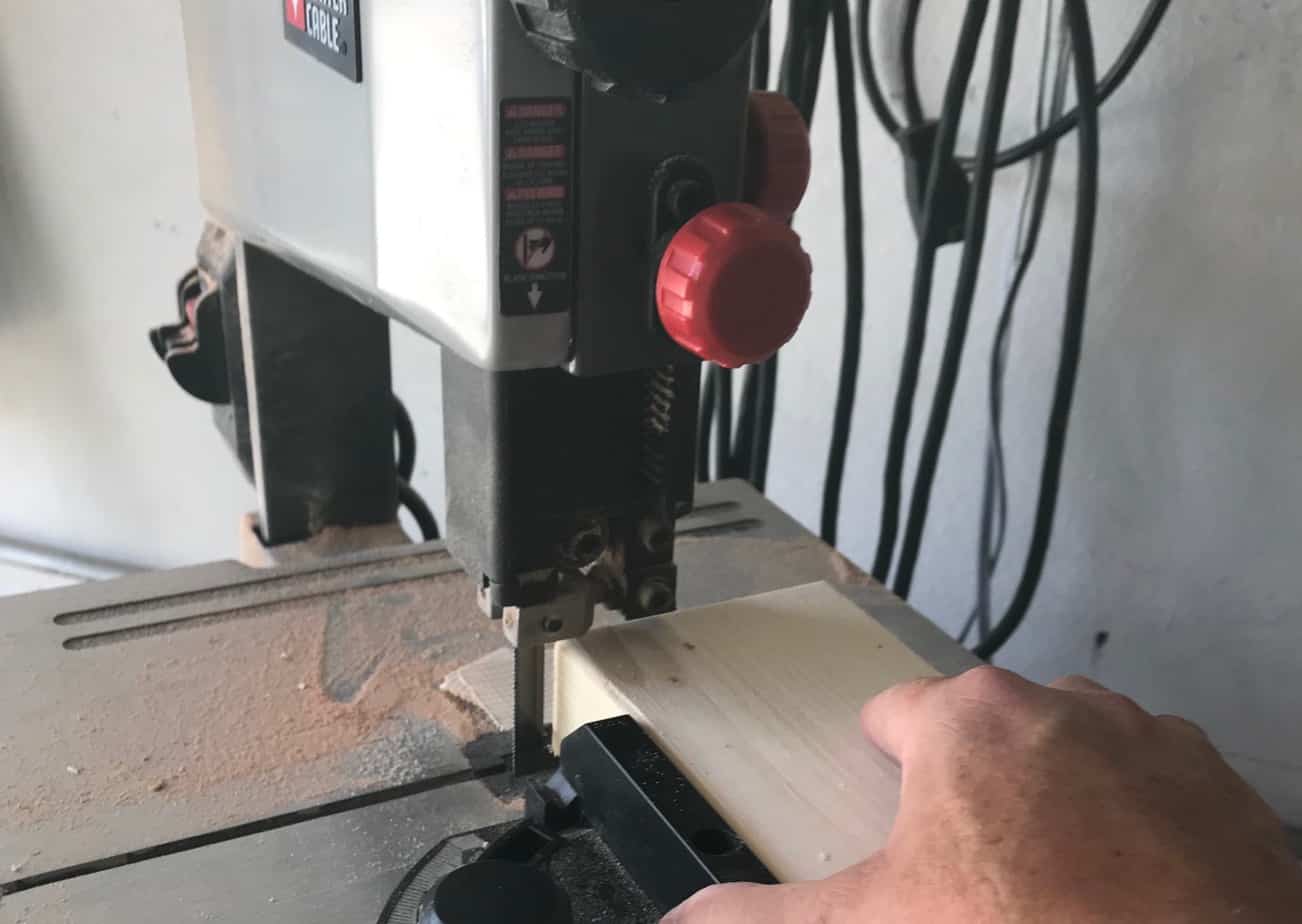A bandsaw can be a very useful tool. However, like all woodworking tools, you need to take care of it. If you don’t, you might notice that it is no longer performing the way you would expect it to and isn’t cutting straight.
There are a few potential issues. First, you might find that the blade has become dull or wasn’t installed properly. You might also be using the wrong blade tension, or the blade guide might not be aligned correctly. Finally, you might be using the wrong type of blade for the material you are cutting.
If your bandsaw doesn’t cut straight it can be a big problem. Projects will be harder to complete. It’s also a big safety concern. Let’s take a closer look at why it might be cutting on an angle and what you can do about it.
You would be surprised how often this question comes up. We talk a lot about random topics like this during our live workshops on Cucamonga Woodworking. You can watch our past workshops on YouTube here(Link to Cucamonga Woodworking)
Why Does My Bandsaw Blade Wander?
Often the bandsaw won’t cut straight because of issues with the blade. It might be dull and need to be replaced. You might also need to re-align the wheels. In other cases, you might need to re-align the guides.
If you’re a woodworker, you must understand why your bandsaw blade is no longer cutting properly. If you don’t catch this issue early, it’s likely to get worse. This can end up damaging the machine and putting your safety at risk. When you notice the blade starts to wander, there are a few things that you should check.
First, you’ll always want to make sure that you are using a sharp blade. Over time your blade will go dull. There are a few ways to tell if the blade you are working with is dull. First, it might start to wander and will no longer cut in a straight line. Another sign is that you need to push the wood through the machine harder, to get it to cut. You might also notice that there are fracture marks on the blade.
When you spot these signs, it’s a good time to change the blade. You should be able to find a replacement in the hardware store. In other cases, you might want to try shopping for them online or contacting the manufacturer and asking for replacements.
After purchasing the blades, you’ll need to make sure that you are attaching them correctly. If you don’t, you might cause the bandsaw to cut at an odd angle. Most blades will come with instructions to help you put them onto the machine properly. If it is a vertical blade, the teeth should be pointed downward. If it’s not, you might need to flip the blade. This should solve the problem. If the blades are correct, but the machine is running the wrong way, you might need to call a qualified mechanic to take a look at it for you.
It’s also a good idea to make sure that the wheels are still aligned. If they come out of alignment, the blade can go crooked. This can cause it to cut at an angle. If this is the problem, you should be able to remove the blade and straighten it up on the wheels. This will solve the issue.
In some cases, you might notice that the wheels have become worn. In this case, it will be impossible for them to hold the blade in place properly. A wheel should have a raised surface, this is where the blade will sit when it’s spinning. Without this, it will move around the wheel, causing it to cut at an angle. When this happens, you’ll need to replace the wheels.
You might also want to consider your technique when pushing material through the machine. You should strive to maintain consistent pressure. If you push one side too hard, you will end up creating a crooked cut. Thankfully, this is the easiest problem to solve, as you won’t need to adjust the machine at all.
Can The Guides Impact How Straight The Blade Is?

The guides can have an impact on how straight the blade will cut. If they are touching the blade, they might cause it to go off-track. They might also impact on how quickly the blade wears out.
Another common reason why the blade wanders is because of the way the guides have been set-up. These are designed to keep the blade cutting straight. If the guides are set in the wrong place, the blade won’t cut properly. To check if this is the problem, look at the guides when you are cutting. They should be close to the blade, but shouldn’t be touching it.
If they are touching the blades, the guides will be putting pressure onto it. This can force the blade off-course. It will also shorten the lifespan of the blade, increasing the chances that it will get scratched or end up cracking. If the guides have been set incorrectly, adjust them, and check again. Ideally, you should have 1/34 inches of space between each guide. This will give you a straight cut, without putting any pressure onto the blade. You might need to check the guides every few months, to make sure that they are still aligned correctly.
How Tight Should A Bandsaw Blade Be?

For a bandsaw to work properly, the blades need to be tight. However, if you overtighten, you risk damaging them and putting your safety at risk. How tight the tension should be will often depend on the type of blade that you have. Generally, it’s recommended that you have around 15,000 to 20,000 psi. This should handle most cuts and slice through most materials.
One of the most common reasons why a blade isn’t cutting straight is because the incorrect amount of tension is being used. This is one of the most important aspects for bandsaw blade owners to understand, so they can make sure that their machine has been set-up properly. It will also allow them to make sure that they are operating safely. Let’s take a closer look at this issue.
What Is Tension?
Let’s start by looking at what blade tension is. Put simply, the blade tension is how tightly the blade has been stretched. The tighter the blade, the higher the tension. The looser it is, the lower the tension.
When setting the blade, you’ll need to make sure that you get the right amount of tension. If it’s too loose, it won’t cut through the wood properly. This can mean that you will need to put extra force onto the wood to get it to cut. In extreme cases, the blade might even come off while you’re cutting. If this happens, it can be a very dangerous situation.
On the other hand, if you set the tension too high, it can also cause some safety concerns. In this case, the blade might snap under the pressure. This can also be a highly dangerous situation, with a high chance that you will be injured. Because of this, all woodworkers must check that they are using the correct bandsaw tension before they start cutting.
What Is The Recommended Tension?
The recommended amount of tension can often depend on the type of blade that you are using. Generally, the manufacturers will recommend using a between 15,000 to 20,000 psi. However, it’s best to double-check this before you start using the machine.
Finding the right amount of tension before you use the bandsaw to start cutting is very important. However, the recommended tension will often depend on the type of blade that you are using. For example, the most common type of blade is carbon steel. In this case, you’ll need to aim for between 15,000 to 20,000 psi. However, if you’re using a tougher blade like a carbide-tipped one, you’ll need to use between 25,000 to 30,000 psi.
If you are unsure about the right amount of tension, check the blade. Many will contain instructions on the right amount of psi. You might also want to vary the tension based on what you are cutting. For example, if you are sawing through tougher materials, like hardwoods, you’ll often need to make sure that you are using more tension. This will keep the cut straight. However, if you are planning on cutting softer materials, you might want to ease off the tension.
Many bandsaws will have a tension scale. However, these tend to be very inaccurate. It’s best to measure the amount of tension on the blade using a tension meter. These can be purchased from most hardware stores, or you can get them online. While they might be a little expensive, they tend to cost around $300, they are the most accurate measure of the tension on the blade. This makes them an essential safety tool for your workshop.
If you don’t yet have a tension meter, you might be able to measure the amount of tension on the blade by hand. In this case, you’ll want to raise the blade by around six inches. Then, push it. If the tension is right, the blade should only move by around ¼ inches. While it won’t be as accurate as a tension meter, this can give you a rough idea of where the blade should be set. This can help you make sure that everything has been set-up properly.
How Do You Adjust The Tension On A Bandsaw Blade?
Now that you know how important the blade tension is, let’s look at how you can adjust it. Tension it until the blade is at the maximum recommended tension. Then slowly release the tension until it starts to flutter. Once you spot this, increase the tension until the fluttering stops.
There are a few ways that you might be able to adjust the tension on the blade. For example, you might want to rely on the tension scale. However, these can often be inaccurate and might not give you the best results. Instead, it’s recommended that you use the flutter technique. This will make it easier for you to get the right tension. It’s also the method that most blade manufacturers recommend.
To use this method, you’ll need to put the new blade in. As you’re doing this, you’ll need to make sure that the machine has been turned off. This will ensure that you can adjust the blade safely. As you’re installing the blade, make sure to center it on the wheels. In some cases, this can mean adjusting the blade by hand. When you’re ready, close the wheel guard.
Next, you’ll need to put some tension on the blade. Try to put it just below the maximum amount of tension recommended for that type of blade. At this point, you will be able to go off the tension scale, as you won’t be leaving it at this tightness for long.
Once you’ve tightened the blade up, start the machine running. Then release the tension. You want to do this as slowly as possible. If you can, try to release a quarter turn at a time. You want to stop when you start to see it flutter on the wheel. After, you see this, slowly increase the tension until the fluttering stops. This should be the ideal tension for your machine. Finally, you’ll need to re-attach the blade guides and you’ll be ready to start cutting wood.
It’s recommended that you re-adjust your tension like this every few months. This will ensure that you are extending the life of the blade. This will also ensure that you’re always using the right amount of tension.
When Should I Change My Bandsaw Blade?
There are a few signs that you might need to change the bandsaw blade. First, you might notice that the blade has become dull. You might also notice that the teeth on the blade are starting to strip off. Most seriously, you might notice hairline cracks starting to appear.
As we mentioned earlier, a dull blade is one of the most common reasons why a bandsaw isn’t cutting straight. When you start to notice the blade dulling, you will have two choices. You can either replace the blade or you can sharpen it. Sharpening the blade can be a great way of saving money, though it can take a little extra time because of the number of teeth you’ll need to work on.
You might also notice that some of the teeth on the blade are starting to get stripped. When this is happening, you will notice that it is starting to become squeaker. In other cases, you might notice that it is starting to produce smoke as it goes through the material. You might also notice that it is harder to push the wood through the machine. When people see this, they suspect that the tension is too low. While this can mask the problem for a while, it’s only a temporary solution. Ultimately, you’ll need to replace the blade.
Finally, when a blade is old and gets worn out, you’ll notice that it will start to develop hairline fractures. This is because it gets hotter as it’s in operation. When you see this, you’ll need to stop using the blade and replace it urgently. It is no longer safe. If you continue to use it, the problem will only get worse and the chances of having a serious accident will continue to increase.
How Long Will A Bandsaw Blade Last?
How long a bandsaw blade will last can vary. In some cases, it might only last for a few months. In other cases, it will last for months. It will all depend on the quality of the blade that you purchase. It might also depend on the type of material that you are cutting.
How long a blade can last will vary significantly. Some people might find that the blades will only last for six months. Others find that it will last them for a few years. One of the most important considerations is the type of blade that you purchase. Some blades will be more strongly well-constructed than others. Usually, the price you pay will give you a good indication of the quality that you can expect.
The longevity of the blade can also be influenced by the way that you are using it. For example, if you are pushing through a lot of hard wood, you will be blunting the blade faster. In other cases, you might risk hitting a nail. This can damage the blade very quickly, and you’ll often need to replace it.
Final Thoughts
Your bandsaw is one of the most important woodworking tools in your garage. However, there might be times when you notice that it is no longer cutting straight. There are a few reasons why this might be happening. First, you might not have set the guides properly. In other cases, you might have an incorrect amount of tension. You might also need to replace the blade. Hopefully, you’ll now have a better idea about what could be causing the issue and how you will be able to fix it.

